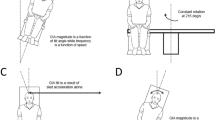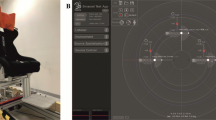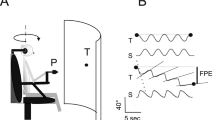Abstract
In self-rotation reproduction tasks, subjects appear to estimate the displacement angle and then reproduce this angle without necessarily replicating the entire temporal velocity profile. In contrast, subjects appear to reproduce the entire temporal velocity profile during linear motion stimulating the otoliths. To investigate what happens during combined rotation and translation, we investigated in darkness the central processing of vestibular cues during eccentric rotation. Controlling a centrifuge with a joystick, nine healthy subjects were asked to reproduce the angle of the previously imposed rotation. Rotations were either ON-center, or 50 cm OFF-center with inter-aural centripetal acceleration. Rotation duration was either variable (proportional to the traveled angle), or constant. We examined whether the stimulation of the otoliths during OFF-center rotation changes self-rotation reproduction, and whether rotation duration is processed differently by the nervous system with and without otolith stimulation. As postulated, the subjects indeed reproduced more closely the stimulus velocity profile when OFF-center. But the primary result is that the additional supra-threshold linear acceleration cues, measured by the otoliths, did not improve performance. More specifically, to our surprise, the ability to reproduce rotation angle degraded slightly in the presence of additional information from the otolith organs, with the linear acceleration cues appearing to interfere with the reproduction of movement duration.

Similar content being viewed by others
References
Angelaki DE (1992) Two-dimensional coding of linear acceleration and the angular velocity sensitivity of the otolith system. Biol Cybern 67:511–521
Angelaki DE, Hess BJ (1996) Three-dimensional organization of otolith-ocular reflexes in rhesus monkeys. 2. Inertial detection of angular velocity. J Neurophysiol 75:2425–2440
Angelaki DE, Merfeld DM, Hess BJM (2000) Low-frequency otolith and semicircular canal interactions after canal inactivation. Exp Brain Res 132:539–549
Becker W, Jürgens R, Boss T (2000) Vestibular perception of self-rotation in different postures: a comparison between sitting and standing subjects. Exp Brain Res 131:468–476
Benson AJ, Spencer MB, Stott JR (1986) Thresholds for the detection of the direction of whole-body, linear movement in the horizontal plane. Aviat Space Environ Med 57:1088–1096
Berthoz A, Israël I, Georges-François P, Grasso R, Tsuzuku T (1995) Spatial memory of body linear displacement: what is being stored? Science 269:95–98
Bloomberg JJ, Melvill Jones G, Segal BN (1991) Adaptive modification of vestibularly perceived rotation. Exp Brain Res 84:47–56
Glasauer S (1992) Interaction of semicircular canals and otoliths in the processing structure of the subjective zenith. Ann N Y Acad Sci 656:847–849
Grasso R, Glasauer S, Georges-François P, Israël I (1999) Replication of passive whole-body linear displacements from inertial cues. Facts and mechanisms. Ann N Y Acad Sci 871:345–366
Hlavacka F, Mergner T, Schweigart G (1992) Interaction of vestibular and proprioceptive inputs for human self-motion perception. Neurosci Lett 138:161–164
Israël I, Glasauer S (1999) Separation between on- and off-center passive motion in darkness. Ann N Y Acad Sci 871:417–421
Israël I, Fetter M, Koenig E (1993) Vestibular perception of passive whole-body rotation about horizontal and vertical axes in humans: goal-directed vestibulo- ocular reflex and vestibular memory-contingent saccades. Exp Brain Res 96:335–346
Israël I, Grasso R, Georges-François P, Tsuzuku T, Berthoz A (1997) Spatial memory and path integration studied by self-driven passive linear displacement.1. Basic properties. J Neurophysiol 77:3180–3192
Israël I, Crockett M, Zupan L, Merfeld D (2001) Le temps influence-t-il les signaux des otolithes? Colloque National des Neurosciences, Toulouse
Ivanenko YP, Grasso R, Israël I, Berthoz A (1997) Spatial orientation in humans: perception of angular whole- body displacements in two-dimensional trajectories. Exp Brain Res 117:419–427
Jürgens R, Boss T, Becker W (1999) Estimation of self-turning in the dark: comparison between active and passive rotation. Exp Brain Res 128:491–504
Marlinsky VV (1999) Vestibular and vestibulo-proprioceptive perception of motion in the horizontal plane in blindfolded man — II. Estimations of rotations about the earth-vertical axis. Neuroscience 90:395–401
Merfeld DM (1995) Modeling human vestibular responses during eccentric rotation and off vertical axis rotation. Acta Otolaryngol (Stockh) 520 (Pt 2):354–359
Merfeld DM, Zupan LH (2002) Neural processing of gravitoinertial cues in humans. III. Modeling tilt and translation responses. J Neurophysiol 87:819–833
Merfeld DM, Zupan L, Peterka RJ (1999) Humans use internal models to estimate gravity and linear acceleration. Nature 398:615–618
Merfeld DM, Zupan LH, Gifford CA (2001) Neural processing of gravito-inertial cues in humans. II. Influence of the semicircular canals during eccentric rotation. J Neurophysiol 85:1648–1660
Mergner T, Siebold C, Schweigart G, Becker W (1991) Human perception of horizontal trunk and head rotation in space during vestibular and neck stimulation. Exp Brain Res 85:389–404
Metcalfe T, Gresty MA (1992) Self-controlled reorienting movements in response to rotational displacements in normal subjects and patients with labyrinthine disease. Ann N Y Acad Sci 656:695–698
Mittelstaedt ML (1995) Influence of centrifugal force on angular velocity estimation. Acta Otolaryngol (Stockh) 115 (Suppl 520) (Pt 2):307–309
Mittelstaedt ML, Jensen W (1999) Centrifugal force affects perception but not nystagmus in passive rotation. Ann N Y Acad Sci 871:435–438
Mittelstaedt ML, Mittelstaedt H (1996) The influence of otoliths and somatic graviceptors on angular velocity estimation. J Vestib Res 6:355–366
Poulton EC (1979) Models for biases in judging sensory magnitude. Psychol Bull 4:777–803
Siegler I, Viaud-Delmon I, Israël I, Berthoz A (2000) Self-motion perception during a sequence of whole-body rotations in darkness. Exp Brain Res 134:66–73
Stevens SS, Greenbaum HS (1966) Regression effect in psychophysical judgment. Percept Psychophys 1:439–446
Yardley L, Gardner M, Lavie N, Gresty MA (1999) Attentional demands of perception of passive self-motion in darkness. Neuropsychologia 37:1293–1301
Young LR (1984) Perception of the body in space: mechanisms. In: Darian-Smith I (ed) Handbook of physiology—the nervous system III. American Physiological Society, Bethesda, pp 1023–1066
Acknowledgements
This work was carried out thanks to the support of NATO (I.I.) and was supported by NIH/NIDCD grant R01 DC04158. We are grateful to our anonymous referees, whose comments helped to greatly improve the final publication.
Author information
Authors and Affiliations
Corresponding author
Rights and permissions
About this article
Cite this article
Israël, I., Crockett, M., Zupan, L. et al. Reproduction of ON-center and OFF-center self-rotations. Exp Brain Res 163, 540–546 (2005). https://doi.org/10.1007/s00221-005-2323-9
Received:
Accepted:
Published:
Issue Date:
DOI: https://doi.org/10.1007/s00221-005-2323-9




